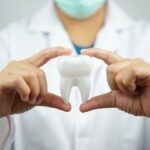Dental offices specializing in aesthetics are increasingly sought after by those who want to have a smile transformation. And porcelain facets are among the most sought-after treatments.
This procedure involves the use of small pieces of porcelain to coat the teeth, making them aesthetically more harmonious and beautiful. Widely used by celebrities and artists, this technique is recommended for correcting stains, recovering cracked teeth, closing gaps between teeth, color changes, shape changes and others.
Even though it is a very sought after technique used by dentists, it is not universally accepted. And that's why, today on our Blog, we're going to talk about this treatment with its advantages and disadvantages and necessary care.
That way, you can better understand the subject and make the right choice for your case.
Keep with us!
First let's understand what dental veneers are.
The use of dental veneers to repair cosmetic damage to teeth, such as fractures and stains, is called dental veneers. They can be made in resin and porcelain, both with satisfactory results.
The treatment works by covering the teeth, restoring the appearance of the smile and adjusting asymmetries and disharmonies. Facets are often confused with dental contact lenses, but they have thicker layers and are indicated in more complex situations.
The dental surgeon is able to restore the color, shape and size of the dental arch using this procedure. In addition to improving the appearance, they can improve the functioning of the teeth, contributing to speech and chewing.
Types of Dental Veneers
There are two different types of dental veneers, depending on the material used to create them: resin veneers and porcelain veneers.
The resin veneer is worked directly on the tooth. The dentist after applying the resin, models the material. This technique is most recommended for those who need to make small changes, such as filling in a space or correcting a fracture.
Porcelain veneers are made in a prosthesis laboratory based on the planning carried out by the dentist. Once ready, they are placed on top of tooth enamel.
Are veneers the same as contact lenses?
They are not. Due to their application similarities, it is possible to confuse veneers with contact lenses. But there are distinctions between them, the most obvious being the thickness of the materials used; on average, facets measure 0.7 mm thick, while lenses are closer to 0.2 mm. Due to this variation, each of these is recommended for different cases.
Today in our article we will focus on porcelain veneers, so what are porcelain veneers?
Porcelain veneers are often suggested when a patient comes to a dentist's office looking to improve their smile, close gaps between their teeth, or correct other dental problems such as a chipped tooth.
Dentists are generally confident in recommending them because of the long-term benefits and excellent esthetic results they provide, even if they are not a solution to every problem.
Porcelain veneers are thin veneers that dentists place on the front surface of teeth using dental cement to permanently change and correct missing teeth. Porcelain veneers are widely used because they resist staining and can reverse tooth discoloration caused by root canal treatment or excessive fluoride use. Stains caused by cigarettes, coffee or drug use can also be covered by porcelain veneers, but it is crucial to understand their advantages and disadvantages.
Indications
A dentist should review each case before recommending porcelain veneers.
Some of the most common uses of porcelain veneers are:
- as an alternative to tooth whitening in more complex cases;
- close spaces between teeth (diastema);
- adjust tooth color (covering stains and discoloration);
- cover cracked, damaged or fractured teeth;
- harmonize the size of the teeth;
- teeth repositioning;
- and to replace yellowed restorations
When the patient and dentist agree that it is necessary, the dental arch can be completely or partially covered with a veneer to improve the overall appearance of the smile. However, the dentist will take into account the contraindications of the procedure, always with the aim of avoiding complications and possible future misalignments.
The use of porcelain veneers affects and improves people's self-esteem, making them feel more confident and attractive.
Contraindications
It is essential to analyze and identify possible complications before performing the procedure, which may make it impossible to use the technique.
One of the main contraindications is in the case of patients who have parafunctional habits or bruxism. There are many cases of patients who break veneers due to habits like these, as the veneer is glued to the tooth, that is, it does not have mechanical resistance. Such habits can be corrected, thus increasing the durability of the veneer.
Pros of porcelain veneers
Porcelain veneers are a very popular option among dental patients because of the many benefits they offer. To name a few:
- White and natural looking teeth
The porcelain used to manufacture the veneers is white and translucent. Light is reflected from it in the same way that it is reflected from tooth enamel. Porcelain veneers look as natural as a person's teeth and as white as they naturally should be. People often don't recognize that the white teeth they admire on their favorite singer, movie star or co-worker are actually porcelain veneers.
- Durability
Another great benefit of porcelain veneer is its durability as it is tough enough to last for years. The porcelain edge is sturdy and durable enough to last for years to come.
The technique is so effective that even after decades of installation, porcelain veneers still look like new. In the vast majority of cases, with the patient taking proper care, avoiding actions such as opening bottles with teeth and the like, veneers can last for decades. Care should be the same as you would with your own teeth.
- stain resistant
Porcelain veneers do not stain like other materials. That is, it will not only give the impression of whiter teeth at first; the effect will last for years. Porcelain veneers can maintain their whiteness for decades with just basic oral hygiene. This is valid even if the person consumes drinks and foods that naturally stain.
- Easy and fast whitening
If you smoke cigarettes, drink coffee or eat highly pigmented foods, your teeth can become yellow and stained over time. Getting the white teeth you want quickly and easily is one of the advantages of porcelain veneers.
Whitening your teeth can take some time and is only a short-term solution to stained teeth. Installing porcelain veneers over stained teeth is advantageous as the stains will be permanently covered.
- immediate results
A benefit of installing porcelain veneers is the speed at which you can see the changes you make. It won't take months of treatment before you see improvements. In most cases, just one or two visits to the dentist will be enough to completely transform your smile.
Another benefit of porcelain veneers is that it does not require time to heal like other dental procedures. After the procedure, you can eat and drink normally.
- Correction of minor aesthetic problems
Minor aesthetic dental problems can be corrected with porcelain veneers. When porcelain veneers are placed on teeth that are stained, chipped, cracked or have gaps between them, porcelain veneers can transform your appearance and improve your self-esteem.
- Replacement of damaged tooth enamel
Tooth enamel is tough, but not indestructible. Consuming acidic foods and drinks over time can erode tooth enamel. Loss of tooth enamel can also be caused by using excessive force when brushing or grinding your teeth on hard objects.
In addition to their aesthetic benefits, porcelain veneers can also be used to repair damaged tooth enamel. Dental veneers can restore the natural appearance of your teeth.
Porcelain veneer cons
Porcelain veneers have many benefits, but there are also some disadvantages that patients should be aware of before deciding whether or not to adhere to treatment. Some of the most frequently encountered disadvantages include:
- can be damaged
Porcelain veneers are not indestructible, that is, if the patient bites hard objects such as pen caps, they may risk cracking and shortening their useful life.
- irreversible procedure
One of the points seen as a disadvantage is the fact that the treatment is irreversible. For the process to be carried out, the dentist needs to remove a thin layer of enamel from the teeth. When a tooth's enamel is removed, it stops growing. This is one of the main disadvantages and biggest problems that some people have with porcelain veneers and that needs to be taken into account when making a decision.
- possible sensitivity
When removing enamel from a tooth to place a porcelain veneer, the tooth may be more sensitive to cold or hot foods and drinks. A disadvantage of veneers is that they do not prevent such drinks and foods that can irritate the teeth. However, tooth sensitivity is often mild, temporary or non-existent.
- Service life compared to dental crowns and bridges
As a general rule, the useful life of porcelain veneers is shorter than that of crowns, bridges and other types of dental restorations. However, this must be taken into account when making the decision.
The important thing is to understand your real need and, together with your dentist, evaluate the best position.
Necessary care after treatment
Many patients neglect their oral health because they feel it is not necessary to clean around their teeth if they have a veneer covering them. That's just a myth.
After treatment, you don't need to make any big changes, just avoid hard foods and maintain your oral hygiene.
See how increasing the durability of veneers is important:
- Avoid using abrasive toothpastes;
- Use a brush with extra soft bristles;
- Avoid drinks and pigmented foods;
- Quit smoking;
- Avoid biting hard objects and biting your nails;
- Visit your dentist regularly.
You may have already realized that porcelain veneers are a great long-term investment, with all its benefits. However, remember to go to an expert to ensure that all your expectations regarding results are met.
How are porcelain veneers applied?
- initial consultation
Finding a dentist you trust who is capable of performing this type of procedure is the first step in placing your veneers. At the beginning, he will determine whether or not you are a candidate for treatment and will also look into whether or not other treatments are needed.
- Pre-treatment procedures
Good oral health is essential for inserting lenses. The dentist can then effectively remove cavities, scrape off tartar and thoroughly clean the area. If you want your teeth to match the veneers you are going to use, you can have a few teeth whitening sessions.
These procedures often require more than one trip to the dentist's office, but they are essential. Schedule an appointment so you can get your new smile as soon as possible.
- molding
After updating your oral health, it's time to mold the arch. The dentist will make a copy of your teeth using suitable material and send it to a laboratory where technicians will design your new smile.
- New smile test
Your caseworker will receive the final diagnosis in a matter of days. This plaster replica of your smile has realistically carved wax teeth to represent your new smile.
Your dentist will take a “test drive”, also known as a mock-up, so that you can see the final product in your own mouth and give your approval or request changes before any permanent work is done.
This step is crucial because, once the veneers are approved and built, it is no longer possible to make changes. So, use this time to answer all of your questions and determine if the shape, size, and color of your teeth are exactly what you want.
- teeth preparation
This is the stage that offers the most revenue to patients: tooth wear. It is necessary to ensure that the veneers fit precisely, which directly affects the durability of the treatment. When everything is perfectly planned and everything is placed in the right positions, wear and tear is minimal.
It is important to emphasize that there is no pain during the entire procedure, as local anesthesia is used.
- Cementation
Once the new smile is approved and the teeth are prepared, the dentist will schedule the cementation. In this case, a very strong glue is employed, bonding each piece of porcelain firmly to the teeth.
Regular visits to the dentist
Regular trips to the dentist are important for many reasons, including the prevention and early treatment of oral health problems and the proper care and maintenance of veneers.
With regular check-ups, the dentist can assess a patient's oral health and advise them on how to maintain good habits.
It is recommended that visits take place at least twice a year, every six months. The dentist may suggest a shorter time interval between visits if they feel it will produce better results.
Dental offices specializing in aesthetics are increasingly sought after by those who want to have a smile transformation. And porcelain facets are among the most sought-after treatments.
This procedure involves the use of small pieces of porcelain to coat the teeth, making them aesthetically more harmonious and beautiful. Widely used by celebrities and artists, this technique is recommended for correcting stains, recovering cracked teeth, closing gaps between teeth, color changes, shape changes and others.
Even though it is a very sought after technique used by dentists, it is not universally accepted. And that's why, today on our Blog, we're going to talk about this treatment with its advantages and disadvantages and necessary care.
That way, you can better understand the subject and make the right choice for your case.
Keep with us!
First let's understand what dental veneers are.
The use of dental veneers to repair cosmetic damage to teeth, such as fractures and stains, is called dental veneers. They can be made in resin and porcelain, both with satisfactory results.
The treatment works by covering the teeth, restoring the appearance of the smile and adjusting asymmetries and disharmonies. Facets are often confused with dental contact lenses, but they have thicker layers and are indicated in more complex situations.
The dental surgeon is able to restore the color, shape and size of the dental arch using this procedure. In addition to improving the appearance, they can improve the functioning of the teeth, contributing to speech and chewing.
Types of Dental Veneers
There are two different types of dental veneers, depending on the material used to create them: resin veneers and porcelain veneers.
The resin veneer is worked directly on the tooth. The dentist after applying the resin, models the material. This technique is most recommended for those who need to make small changes, such as filling in a space or correcting a fracture.
Porcelain veneers are made in a prosthesis laboratory based on the planning carried out by the dentist. Once ready, they are placed on top of tooth enamel.
Are veneers the same as contact lenses?
They are not. Due to their application similarities, it is possible to confuse veneers with contact lenses. But there are distinctions between them, the most obvious being the thickness of the materials used; on average, facets measure 0.7 mm thick, while lenses are closer to 0.2 mm. Due to this variation, each of these is recommended for different cases.
Today in our article we will focus on porcelain veneers, so what are porcelain veneers?
Porcelain veneers are often suggested when a patient comes to a dentist's office looking to improve their smile, close gaps between their teeth, or correct other dental problems such as a chipped tooth.
Dentists are generally confident in recommending them because of the long-term benefits and excellent esthetic results they provide, even if they are not a solution to every problem.
Porcelain veneers are thin veneers that dentists place on the front surface of teeth using dental cement to permanently change and correct missing teeth. Porcelain veneers are widely used because they resist staining and can reverse tooth discoloration caused by root canal treatment or excessive fluoride use. Stains caused by cigarettes, coffee or drug use can also be covered by porcelain veneers, but it is crucial to understand their advantages and disadvantages.
Indications
A dentist should review each case before recommending porcelain veneers.
Some of the most common uses of porcelain veneers are:
- as an alternative to tooth whitening in more complex cases;
- close spaces between teeth (diastema);
- adjust tooth color (covering stains and discoloration);
- cover cracked, damaged or fractured teeth;
- harmonize the size of the teeth;
- teeth repositioning;
- and to replace yellowed restorations
When the patient and dentist agree that it is necessary, the dental arch can be completely or partially covered with a veneer to improve the overall appearance of the smile. However, the dentist will take into account the contraindications of the procedure, always with the aim of avoiding complications and possible future misalignments.
The use of porcelain veneers affects and improves people's self-esteem, making them feel more confident and attractive.
Contraindications
It is essential to analyze and identify possible complications before performing the procedure, which may make it impossible to use the technique.
One of the main contraindications is in the case of patients who have parafunctional habits or bruxism. There are many cases of patients who break veneers due to habits like these, as the veneer is glued to the tooth, that is, it does not have mechanical resistance. Such habits can be corrected, thus increasing the durability of the veneer.
Pros of porcelain veneers
Porcelain veneers are a very popular option among dental patients because of the many benefits they offer. To name a few:
- White and natural looking teeth
The porcelain used to manufacture the veneers is white and translucent. Light is reflected from it in the same way that it is reflected from tooth enamel. Porcelain veneers look as natural as a person's teeth and as white as they naturally should be. People often don't recognize that the white teeth they admire on their favorite singer, movie star or co-worker are actually porcelain veneers.
- Durability
Another great benefit of porcelain veneer is its durability as it is tough enough to last for years. The porcelain edge is sturdy and durable enough to last for years to come.
The technique is so effective that even after decades of installation, porcelain veneers still look like new. In the vast majority of cases, with the patient taking proper care, avoiding actions such as opening bottles with teeth and the like, veneers can last for decades. Care should be the same as you would with your own teeth.
- stain resistant
Porcelain veneers do not stain like other materials. That is, it will not only give the impression of whiter teeth at first; the effect will last for years. Porcelain veneers can maintain their whiteness for decades with just basic oral hygiene. This is valid even if the person consumes drinks and foods that naturally stain.
- Easy and fast whitening
If you smoke cigarettes, drink coffee or eat highly pigmented foods, your teeth can become yellow and stained over time. Getting the white teeth you want quickly and easily is one of the advantages of porcelain veneers.
Whitening your teeth can take some time and is only a short-term solution to stained teeth. Installing porcelain veneers over stained teeth is advantageous as the stains will be permanently covered.
- immediate results
A benefit of installing porcelain veneers is the speed at which you can see the changes you make. It won't take months of treatment before you see improvements. In most cases, just one or two visits to the dentist will be enough to completely transform your smile.
Another benefit of porcelain veneers is that it does not require time to heal like other dental procedures. After the procedure, you can eat and drink normally.
- Correction of minor aesthetic problems
Minor aesthetic dental problems can be corrected with porcelain veneers. When porcelain veneers are placed on teeth that are stained, chipped, cracked or have gaps between them, porcelain veneers can transform your appearance and improve your self-esteem.
- Replacement of damaged tooth enamel
Tooth enamel is tough, but not indestructible. Consuming acidic foods and drinks over time can erode tooth enamel. Loss of tooth enamel can also be caused by using excessive force when brushing or grinding your teeth on hard objects.
In addition to their aesthetic benefits, porcelain veneers can also be used to repair damaged tooth enamel. Dental veneers can restore the natural appearance of your teeth.
Porcelain veneer cons
Porcelain veneers have many benefits, but there are also some disadvantages that patients should be aware of before deciding whether or not to adhere to treatment. Some of the most frequently encountered disadvantages include:
- can be damaged
Porcelain veneers are not indestructible, that is, if the patient bites hard objects such as pen caps, they may risk cracking and shortening their useful life.
- irreversible procedure
One of the points seen as a disadvantage is the fact that the treatment is irreversible. For the process to be carried out, the dentist needs to remove a thin layer of enamel from the teeth. When a tooth's enamel is removed, it stops growing. This is one of the main disadvantages and biggest problems that some people have with porcelain veneers and that needs to be taken into account when making a decision.
- possible sensitivity
When removing enamel from a tooth to place a porcelain veneer, the tooth may be more sensitive to cold or hot foods and drinks. A disadvantage of veneers is that they do not prevent such drinks and foods that can irritate the teeth. However, tooth sensitivity is often mild, temporary or non-existent.
- Service life compared to dental crowns and bridges
As a general rule, the useful life of porcelain veneers is shorter than that of crowns, bridges and other types of dental restorations. However, this must be taken into account when making the decision.
The important thing is to understand your real need and, together with your dentist, evaluate the best position.
Necessary care after treatment
Many patients neglect their oral health because they feel it is not necessary to clean around their teeth if they have a veneer covering them. That's just a myth.
After treatment, you don't need to make any big changes, just avoid hard foods and maintain your oral hygiene.
See how increasing the durability of veneers is important:
- Avoid using abrasive toothpastes;
- Use a brush with extra soft bristles;
- Avoid drinks and pigmented foods;
- Quit smoking;
- Avoid biting hard objects and biting your nails;
- Visit your dentist regularly.
You may have already realized that porcelain veneers are a great long-term investment, with all its benefits. However, remember to go to an expert to ensure that all your expectations regarding results are met.
How are porcelain veneers applied?
- initial consultation
Finding a dentist you trust who is capable of performing this type of procedure is the first step in placing your veneers. At the beginning, he will determine whether or not you are a candidate for treatment and will also look into whether or not other treatments are needed.
- Pre-treatment procedures
Good oral health is essential for inserting lenses. The dentist can then effectively remove cavities, scrape off tartar and thoroughly clean the area. If you want your teeth to match the veneers you are going to use, you can have a few teeth whitening sessions.
These procedures often require more than one trip to the dentist's office, but they are essential. Schedule an appointment so you can get your new smile as soon as possible.
- molding
After updating your oral health, it's time to mold the arch. The dentist will make a copy of your teeth using suitable material and send it to a laboratory where technicians will design your new smile.
- New smile test
Your caseworker will receive the final diagnosis in a matter of days. This plaster replica of your smile has realistically carved wax teeth to represent your new smile.
Your dentist will take a “test drive”, also known as a mock-up, so that you can see the final product in your own mouth and give your approval or request changes before any permanent work is done.
This step is crucial because, once the veneers are approved and built, it is no longer possible to make changes. So, use this time to answer all of your questions and determine if the shape, size, and color of your teeth are exactly what you want.
- teeth preparation
This is the stage that offers the most revenue to patients: tooth wear. It is necessary to ensure that the veneers fit precisely, which directly affects the durability of the treatment. When everything is perfectly planned and everything is placed in the right positions, wear and tear is minimal.
It is important to emphasize that there is no pain during the entire procedure, as local anesthesia is used.
- Cementation
Once the new smile is approved and the teeth are prepared, the dentist will schedule the cementation. In this case, a very strong glue is employed, bonding each piece of porcelain firmly to the teeth.
Regular visits to the dentist
Regular trips to the dentist are important for many reasons, including the prevention and early treatment of oral health problems and the proper care and maintenance of veneers.
With regular check-ups, the dentist can assess a patient's oral health and advise them on how to maintain good habits.
It is recommended that visits take place at least twice a year, every six months. The dentist may suggest a shorter time interval between visits if they feel it will produce better results.










 per
per